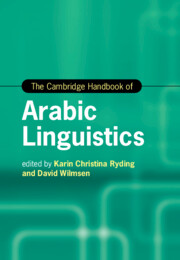Book contents
- The Cambridge Handbook of Arabic Linguistics
- Cambridge Handbooks in Language and Linguistics
- The Cambridge Handbook of Arabic Linguistics
- Copyright page
- Contents
- Figures
- Tables
- Notes on Contributors
- Acknowledgements
- Abbreviations
- Introduction
- Part I Arabic Applied Linguistics
- Part II Arabic Variation and Sociolinguistics
- Part III Theoretical and Descriptive Studies
- Part IV Arabic Computational and Corpus Linguistics
- 18 Arabic Computational Linguistics
- 19 Arabic Corpus Linguistics and Related Tools
- 20 The Utility of Arabic Corpus Linguistics
- Part V Arabic Linguistics and New Media Studies
- Part VI Arabic Linguistics in Literature and Translation
- Index
- References
18 - Arabic Computational Linguistics
from Part IV - Arabic Computational and Corpus Linguistics
Published online by Cambridge University Press: 23 September 2021
- The Cambridge Handbook of Arabic Linguistics
- Cambridge Handbooks in Language and Linguistics
- The Cambridge Handbook of Arabic Linguistics
- Copyright page
- Contents
- Figures
- Tables
- Notes on Contributors
- Acknowledgements
- Abbreviations
- Introduction
- Part I Arabic Applied Linguistics
- Part II Arabic Variation and Sociolinguistics
- Part III Theoretical and Descriptive Studies
- Part IV Arabic Computational and Corpus Linguistics
- 18 Arabic Computational Linguistics
- 19 Arabic Corpus Linguistics and Related Tools
- 20 The Utility of Arabic Corpus Linguistics
- Part V Arabic Linguistics and New Media Studies
- Part VI Arabic Linguistics in Literature and Translation
- Index
- References
Summary
This chapter presents an easily followed overview of computational linguistics and where Arabic fits into it. Computational linguistics, often referred to interchangeably as natural language processing (NLP) or human language technologies, is a large and growing interdisciplinary field of research that lies at the intersection of linguistics, computer science, electrical engineering, cognitive science, psychology, pedagogy, and mathematics, among other fields. Research and work on Arabic computational linguistics has lagged behind English and other languages. This is despite a tremendous increase in the relative growth of Arabic NLP in the period between 2012 and 2016. The reason for its slow start is that Arabic presents a series of difficulties to programmers, those being morphological richness, orthographic ambiguity, dialectal variations, orthographic noise, and resource poverty. Those problems have been or are being overcome, and a new generation of researchers has made great strides in the field. This has partly to do with the growing interest in language technologies for opinion mining and translation in social media, which features dialectal Arabic more than MSA. Another motivation is that commercial giants like Apple and Google are interested in applications of Arabic as it is spoken.
Keywords
- Type
- Chapter
- Information
- The Cambridge Handbook of Arabic Linguistics , pp. 427 - 445Publisher: Cambridge University PressPrint publication year: 2021



